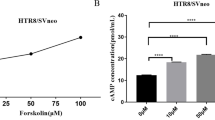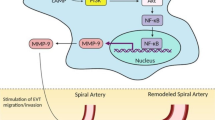Abstract
The proliferation and apoptosis of cells in the placenta play a critical role in preeclampsia (PE) in which estrogen has been implicated via estrogen receptors (ERs). A novel ER, G-protein-coupled receptor 30 (GPR30), has recently been shown to be involved in PE. We investigated the basic levels of proliferation and apoptosis in normal placentae and placentae with PE and compared GPR30 expression levels between the two groups. We demonstrated that low GPR30 expression levels, more apoptosis, and less proliferation were associated with PE. Moreover, our in vitro study showed that both the selective GPR30 agonist G1 and the general ER agonist 17-β-estradiol were able to protect the placenta from hypoxia-reoxygenation injuries, resulting in decreased apoptosis and increased proliferation. Furthermore, this protective effect was abolished by the addition of the selective GPR30 inhibitor G15. These results provide evidence that (1) GPR30 is involved in regulating cell proliferation and apoptosis; (2) pharmacologic upregulation of GPR30 is beneficial for PE management; (3) GPR30 may therefore be an interventional target for pregnancies complicated by PE.




Similar content being viewed by others
References
Abimanyu B (2014) The role of angiogenic factors in pre-eclampsia. Pregnancy Hypertens 4:246
Can M, Guven B, Bektas S, Arikan I (2014) Oxidative stress and apoptosis in preeclampsia. Tissue Cell 46:477–481
Corcoran JJ, Nicholson C, Sweeney M, Charnock JC, Robson SC, Westwood M, Taggart MJ (2014) Human uterine and placental arteries exhibit tissue-specific acute responses to 17beta-estradiol and estrogen-receptor-specific agonists. Mol Hum Reprod 20:433–441
D’Souza V, Rani A, Patil V, Pisal H, Randhir K, Mehendale S, Wagh G, Gupte S, Joshi S (2016) Increased oxidative stress from early pregnancy in women who develop preeclampsia. Clin Exp Hypertens 38:225–232
Du GQ, Zhou L, Chen XY, Wan XP, He YY (2012) The G protein-coupled receptor GPR30 mediates the proliferative and invasive effects induced by hydroxytamoxifen in endometrial cancer cells. Biochem Biophys Res Commun 420:343–349
Erboga M, Kanter M (2015) Trophoblast cell proliferation and apoptosis in placental development during early gestation period in rats. Anal Quant Cytopathol Histpathol 37:286–294
Grygiel-Gorniak B, Puszczewicz M (2016) The complications of systemic sclerosis in pregnancy—diagnostic and therapeutic difficulties. Pol Merkur Lekarski 40:61–65
Heino TJ, Chagin AS, Savendahl L (2008) The novel estrogen receptor G-protein-coupled receptor 30 is expressed in human bone. J Endocrinol 197:R1–R6
Jiang X, Ye X, Ma J, Li W, Wu R, Jun L (2015) G protein-coupled estrogen receptor 1 (GPER 1) mediates estrogen-induced, proliferation of leiomyoma cells. Gynecol Endocrinol 31:894–898
Jido TA, Yakasai IA (2013) Preeclampsia: a review of the evidence. Ann Afr Med 12:75–85
Kolkova Z, Noskova V, Ehinger A, Hansson S, Casslen B (2010) G protein-coupled estrogen receptor 1 (GPER, GPR 30) in normal human endometrium and early pregnancy decidua. Mol Hum Reprod 16:743–751
Kyathanahalli C, Organ K, Moreci RS, Anamthathmakula P, Hassan SS, Caritis SN, Jeyasuria P, Condon JC (2015) Uterine endoplasmic reticulum stress-unfolded protein response regulation of gestational length is caspase-3 and -7-dependent. Proc Natl Acad Sci U S A 112:14090–14095
Leslie K, Whitley GS, Herse F, Dechend R, Ashton SV, Laing K, Thilaganathan B, Cartwright JE (2015) Increased apoptosis, altered oxygen signaling, and antioxidant defenses in first-trimester pregnancies with high-resistance uterine artery blood flow. Am J Pathol 185:2731–2741
Lindsey SH, Chappell MC (2011) Evidence that the G protein-coupled membrane receptor GPR30 contributes to the cardiovascular actions of estrogen. Gend Med 8:343–354
Maggiolini M, Picard D (2010) The unfolding stories of GPR30, a new membrane-bound estrogen receptor. J Endocrinol 204:105–114
Mata KM, Li W, Reslan OM, Siddiqui WT, Opsasnick LA, Khalil RA (2015) Adaptive increases in expression and vasodilator activity of estrogen receptor subtypes in a blood vessel-specific pattern during pregnancy. Am J Physiol Heart Circ Physiol 309:H1679–H1696
Meyer MR, Prossnitz ER, Barton M (2011) The G protein-coupled estrogen receptor GPER/GPR30 as a regulator of cardiovascular function. Vasc Pharmacol 55:17–25
Mol BW, Roberts CT, Thangaratinam S, Magee LA, de Groot CJ, Hofmeyr GJ (2015) Pre-eclampsia. Lancet 387:999–1011
Myatt L, Roberts JM (2015) Preeclampsia: syndrome or disease? Curr Hypertens Rep 17:83
Nandi P, Siddiqui MF, Lala PK (2016) Restraint of trophoblast invasion of the uterus by decorin: role in pre-eclampsia. Am J Reprod Immunol 75:351–360
Petrie WK, Dennis MK, Hu C, Dai D, Arterburn JB, Smith HO, Hathaway HJ, Prossnitz ER (2013) G protein-coupled estrogen receptor-selective ligands modulate endometrial tumor growth. Obstet Gynecol Int 2013:472720
Redman C (2014a) Pre-eclampsia: a complex and variable disease. Pregnancy Hypertens 4:241–242
Redman C (2014b) The six stages of pre-eclampsia. Pregnancy Hypertens 4:246
Reis FM, Bloise E, Ortiga-Carvalho TM (2015) Hormones and pathogenesis of uterine fibroids. Best Pract Res Clin Obstet Gynaecol (in press)
Revankar CM, Cimino DF, Sklar LA, Arterburn JB, Prossnitz ER (2005) A transmembrane intracellular estrogen receptor mediates rapid cell signaling. Science 307:1625–1630
Ronda AC, Boland RL (2016) Intracellular distribution and involvement of GPR30 in the actions of E2 on C2C12 cells. J Cell Biochem 117:793–805
Scaling AL, Prossnitz ER, Hathaway HJ (2014) GPER mediates estrogen-induced signaling and proliferation in human breast epithelial cells and normal and malignant breast. Horm Cancer 5:146–160
Shang D, Li Z, Zhu Z, Chen H, Zhao L, Wang X, Chen Y (2015) Baicalein suppresses 17-beta-estradiol-induced migration, adhesion and invasion of breast cancer cells via the G protein-coupled receptor 30 signaling pathway. Oncol Rep 33:2077–2085
Sulistyowati S (2014) The role of oxidative stress in the pathogenesis of pre-eclampsia. Pregnancy Hypertens 4:244
Takada Y, Kato C, Kondo S, Korenaga R, Ando J (1997) Cloning of cDNAs encoding G protein-coupled receptor expressed in human endothelial cells exposed to fluid shear stress. Biochem Biophys Res Commun 240:737–741
Thomas P, Pang Y, Filardo EJ, Dong J (2005) Identity of an estrogen membrane receptor coupled to a G protein in human breast cancer cells. Endocrinology 146:624–632
Toda N, Toda H, Okamura T (2013) Regulation of myometrial circulation and uterine vascular tone by constitutive nitric oxide. Eur J Pharmacol 714:414–423
Tong C, Feng X, Chen J, Qi X, Zhou L, Shi S, Kc K, Stanley JL, Baker PN, Zhang H (2016) G protein-coupled receptor 30 regulates trophoblast invasion and its deficiency is associated with preeclampsia. J Hypertens 34:710–718
Tran QK, Firkins R, Giles J, Francis S, Matnishian V, Tran P, VerMeer M, Jasurda J, Burgard MA, Gebert-Oberle B (2016) Estrogen enhances linkage in the vascular endothelial calmodulin network via a feedforward mechanism at the G protein-coupled estrogen receptor 1. J Biol Chem 291:10805–10823
Tropea T, De Francesco EM, Rigiracciolo D, Maggiolini M, Wareing M, Osol G, Mandala M (2015) Pregnancy augments G protein estrogen receptor (GPER) induced vasodilation in rat uterine arteries via the nitric oxide - cGMP signaling pathway. PLoS One 10:e0141997
Turner RJ, Bloemenkamp KW, Bruijn JA, Baelde HJ (2016) Loss of thrombomodulin in placental dysfunction in preeclampsia. Arterioscler Thromb Vasc Biol 36:728–735
Turpin CA, Sakyi SA, Owiredu WK, Ephraim RK, Anto EO (2015) Association between adverse pregnancy outcome and imbalance in angiogenic regulators and oxidative stress biomarkers in gestational hypertension and preeclampsia. BMC Pregnancy Childbirth 15:189
Wei W, Chen ZJ, Zhang KS, Yang XL, Wu YM, Chen XH, Huang HB, Liu HL, Cai SH, Du J, Wang HS (2014) The activation of G protein-coupled receptor 30 (GPR30) inhibits proliferation of estrogen receptor-negative breast cancer cells in vitro and in vivo. Cell Death Dis 5:e1428
Welsh T, Johnson M, Yi L, Tan H, Rahman R, Merlino A, Zakar T, Mesiano S (2012) Estrogen receptor (ER) expression and function in the pregnant human myometrium: estradiol via ERalpha activates ERK1/2 signaling in term myometrium. J Endocrinol 212:227–238
Wrobel AM, Gregoraszczuk EL (2015) Action of methyl-, propyl- and butylparaben on GPR30 gene and protein expression, cAMP levels and activation of ERK1/2 and PI3K/Akt signaling pathways in MCF-7 breast cancer cells and MCF-10A non-transformed breast epithelial cells. Toxicol Lett 238:110–116
Author information
Authors and Affiliations
Corresponding author
Additional information
Jianxin Li and Zhu Chen contributed equally to this work.
This study was financially supported by the National Natural Science Foundation of China (grant nos. 81370732 and 81571453).
Rights and permissions
About this article
Cite this article
Li, J., Chen, Z., Zhou, X. et al. Imbalance between proliferation and apoptosis−related impaired GPR30 expression is involved in preeclampsia. Cell Tissue Res 366, 499–508 (2016). https://doi.org/10.1007/s00441-016-2466-y
Received:
Accepted:
Published:
Issue Date:
DOI: https://doi.org/10.1007/s00441-016-2466-y




